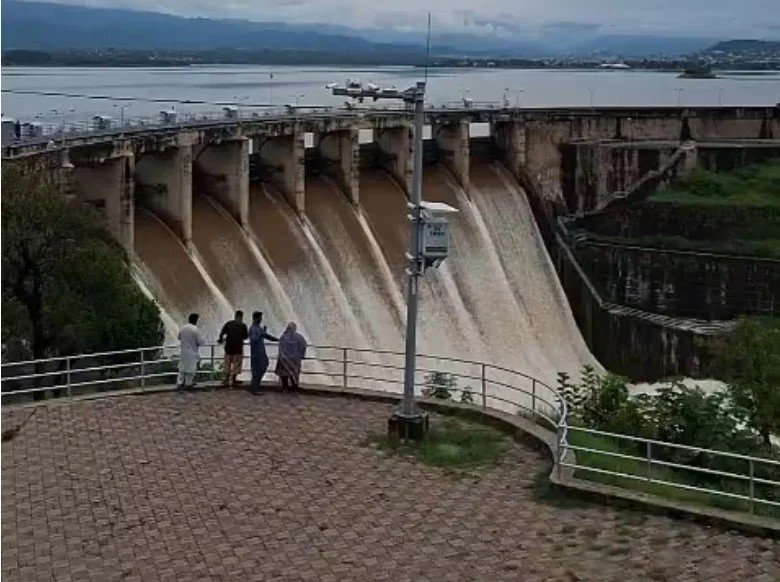
In response to the heavy monsoon rains that have swept through the region, authorities in Islamabad opened the spillways of Rawal Dam as water levels approached the dam’s maximum storage capacity. The step, described as precautionary and crucial, was taken to avert any potential flooding and safeguard the structural integrity of the dam.
Background and Importance of Rawal Dam
Rawal Dam, situated in the Margalla Hills National Park area near Islamabad, is a key reservoir that supplies drinking water to the twin cities of Islamabad and Rawalpindi. Constructed in 1962 on the Korang River, the dam plays a critical role in regional water management, flood control, and local ecology.
The full conservation level of Rawal Dam is 1,752 feet above sea level. As of July 20, 2025, the water level had reached approximately 1,749 feet—alarmingly close to its full capacity. With continued rainfall forecast in the coming days, authorities decided to open the spillways to release excess water.
Spillways Opened for Controlled Release
The spillways were opened early in the morning on July 20 and remained open for approximately five hours. This controlled release allowed the water level to drop to a safer range, near 1,746 feet. Officials from the Water and Sanitation Agency (WASA) and the Islamabad Capital Territory (ICT) administration oversaw the operation, ensuring that the release was gradual to prevent downstream flooding.
The released water flowed into the Korang River and ultimately into the Soan River. Fortunately, the surrounding areas were preemptively alerted, and no damage to property or loss of life has been reported as a result of the operation.
Precautionary Measures and Public Safety
Before opening the spillways, the district administration issued warnings to residents living near low-lying areas downstream of the dam. Announcements were made through various media outlets, and rescue teams were deployed near the riverbanks. Police and emergency response units were kept on high alert to deal with any unexpected situation.
Recreational activities around Rawal Lake, such as boating and fishing, were temporarily suspended for safety reasons. Visitors to the Rawal Lake View Park and surrounding picnic spots were advised to avoid the area until the water levels normalized.
Meteorological Outlook and Climate Impacts
According to the Pakistan Meteorological Department (PMD), the current monsoon spell is among the most intense recorded in recent years. Islamabad and surrounding areas received over 150 mm of rain within a 24-hour period, pushing dams, rivers, and drainage systems to their limits.
Experts attribute these extreme weather events to changing climate patterns and increased variability in monsoon behavior. More frequent and intense rainfall events are putting pressure on urban infrastructure and natural reservoirs like Rawal Dam.
Expert Opinions and Public Reactions
Dr. Faisal Rahim, a hydrology expert at Quaid-i-Azam University, stated:
“Opening the spillways was a necessary and timely decision. Had the water breached the maximum level, it could have caused damage to the dam or triggered flash floods in surrounding areas.”
Many residents appreciated the transparency and prompt action of the local administration. A Rawalpindi resident, Sajid Mehmood, shared:
“We were worried when the rain didn’t stop for two days, but the early warning and management by the authorities helped avoid panic and damage.”
However, some citizens also pointed to the need for better long-term planning, including improved drainage systems and real-time flood monitoring networks, especially as Pakistan continues to face the brunt of climate change.
Moving Forward
Rawal Dam is just one of several reservoirs in Pakistan that face pressure during the monsoon season. With climate unpredictability increasing, such emergency spillway operations may become more frequent in the coming years. Authorities have emphasized the importance of public cooperation, infrastructure upgrades, and inter-agency coordination to handle such events more efficiently in the future.
The recent incident serves as a reminder of both the blessings and the dangers that come with the monsoon season. While rainfall replenishes water reservoirs and supports agriculture, it also requires vigilant water management to prevent disasters.
Conclusion
The opening of Rawal Dam’s spillways was a well-coordinated and precautionary action that successfully prevented potential flooding in the region. With weather systems becoming increasingly volatile, continued investment in climate-resilient infrastructure and timely public communication will be essential in safeguarding both lives and livelihoods.
Reference: راول ڈیم میں پانی کی بلند ترین سطح پر سپل ویز کھول دیئے گئے

